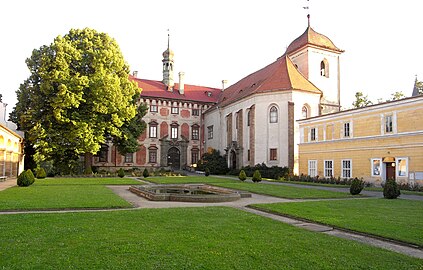Libochovice Castle
The Libochovice Castle (German Libochowitz Castle ) is located in Libochovice in Okres Litoměřice in the Czech Republic on the lower reaches of the Eger . It is one of the important early baroque castles in Bohemia .
history
Gothic festivals in the early Middle Ages
The beginnings, a wooden fortress on the left bank of the Eger, where today's castle stands, as well as the beginnings of the nearby Hazmburk Castle and smaller settlements surrounded by ramparts, date back to the 12th century or even earlier. In 1205 the Libochovice fortress belonged to the Klapy estate. In 1336 Johann von Böhmen sold this to the Zajíc von Hasenburg , who renamed Klapy Castle in Hasenburg Castle after the rabbit in their coat of arms and had it converted into a heavily fortified Gothic castle. At the beginning of the 15th century they converted the wooden fortresses on the Eger river into a habitable fortress in the Gothic style . Nothing remains of this building, which was burned down by the Hussites .
Conversion to a castle
Johann Hase von Hasenburg auf Budin und Libochowitz, the highest Hereditary Marshal in the Kingdom of Bohemia, had a Renaissance castle with a chapel in the late Gothic style built as his residence in 1560–1564 , which was used for a longer period in church buildings. From 1594 to 1613, until the confiscation, the castle and manor were owned by the Lobkowicz lords . After them the property came to the Lords of Sternberg .
During a devastating fire in the subject town of Libochowitz in 1661, the palace and the palace chapel were also hit. Only parts of the masonry remained. In 1676 Wenzel Adalbert von Sternberg sold the building to Gundekar von Dietrichstein zu Nikolsburg, who in 1682 commissioned the construction and reconstruction of the palace in the style of the time.
The Libochovice Castle was expanded in the early Baroque style from 1683 to 1690 according to plans by Antonio della Porta , who also directed the construction of the nearby Roudnice nad Labem Castle , but its floor plan was retained. The red coloring of the surrounding walls has been renewed. In the following time after 1848 a granary and a schnapps distillery were set up in the chapel. Renaissance paintings have been preserved under today's baroque plastering.
From the last majorate owner Josef Reichsfürst von Dietrichstein zu Nikolsburg (1847-1858), the majorate passed to his eldest daughter Theresia (1822-1909), who, according to the family contract, inherited the Fideikommiss Budin and Libochowitz with the Libochowitz Palace and when she married Count Friedrich von Herberstein and Proskau, governors of Styria , brought in as dowry, and their descendants were owners until 1945 and the nationalization in favor of Czechoslovakia .
Interior and museum
In the south wing of the palace there is the Saturn Hall, named after the Roman god of agriculture, Saturn , which has two floors and was the palace's ballroom. The fireplace, equipped with statues of the four seasons made of stucco and stone, in which the statue of the Roman god Saturn protrudes surrounded by cupids in plastic clouds, is attributed to a design by Johann Brokoff . The hall is decorated with a ceiling with articulated chandeliers. The large wall paintings in the hall are works by the baroque painter Christian Schröder (painter) , copies by Tizian, Tintoretto, Veronese, Rubens, which were made for the client Gundekar von Dietrichstein zu Nikolsburg, whose portrait dominates in a large painting. The names of the major rulers are recorded on signs above the windows.
The other interiors, for example the salla terenna , the small and large gallery, the study, the oriental salon, the baroque bedrooms, the large dining room, the games room and the library reflect the changes in architectural styles from the baroque to the styles of the 19th century. Century. In addition to furniture, the palace also houses collections of tapestries , pictures, glass and porcelain. On the ground floor there is a permanent exhibition about the life and work of Jan Evangelista Purkyně . Born in the castle as the son of a princely administrative officer, he became one of the most important Bohemian physiologists.
Landscaped garden
The French garden was laid out from 1685 by the palace gardener Jan Tulip (Tulipán) based on the model of the gardens of Versailles . This also included an orangery . The baroque fountains are the work of Jakob Mitthofer. In the 19th century, these facilities expanded an English landscape garden . The park was renewed in 1912 by Josef Rublič, the author of the brochure: Two Hundred Years of the Libochowitz Castle Garden in Bohemia, 1940.
Libochovice Castle is open to the general public and can be visited.
literature
- Joachim Bahlcke , Winfried Eberhard, Miloslav Polívka (eds.): Handbook of historical places . Volume: Bohemia and Moravia (= Kröner's pocket edition . Volume 329). Kröner, Stuttgart 1998, ISBN 3-520-32901-8 .
- Emanuel Poche: Art Monuments in Czechoslovakia. Bohemia and Moravia. Edition Leipzig 1986, ISBN 3-361-00071-8 .
- Josef Weiss: The State Castle Libochovice, Guide. Publisher: District Administration of State Preservation of Monuments and Nature Conservation in Usti nad Labem (Aussig on the Elbe), District National Committee in Litomerice (Leitmeritz), 1973.
- Mapa hradu a zamku Ceskoslovenska, Kartographia Praha 1971, Libochovice page 67.
- Vinzenz Uhl: Castles and palaces of the Ore Mountains and Egertal. Kaaden, 1935.
Web links
Individual evidence
- ^ Procházka novel : Genealogical handbook of extinct Bohemian gentry families. Supplementary volume, edited by the board of the Collegium Carolinum (Institute) Research Center for the Bohemian Lands, Munich 1990, p. 31
- ^ History of Libochovice Castle (Czech) (accessed November 28, 2017)
Coordinates: 50 ° 24 ′ 31 ″ N , 14 ° 2 ′ 30 ″ E




